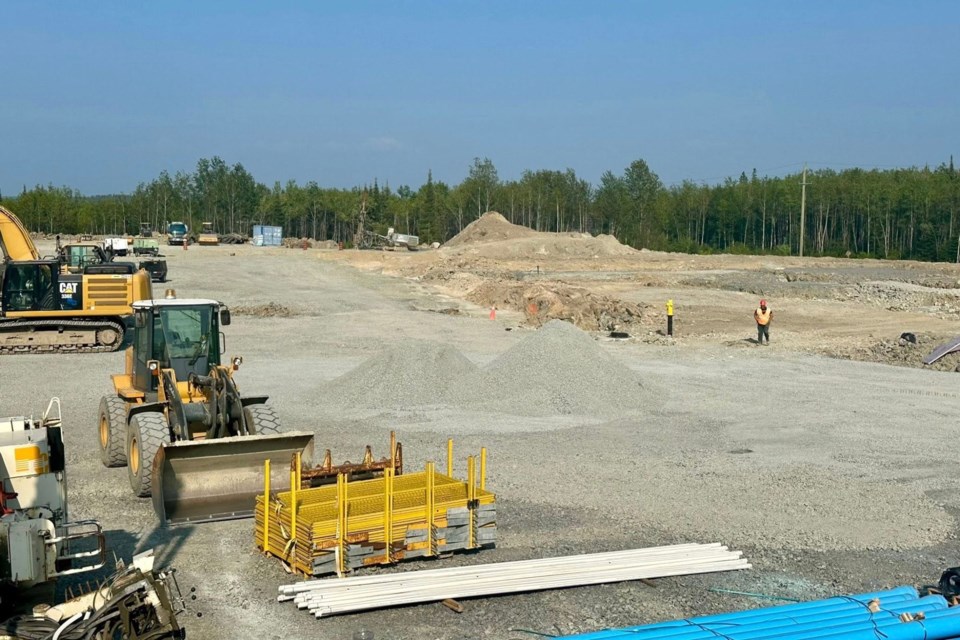KIRKLAND LAKE — Construction is underway on a $20-million modular home manufacturing facility in Kirkland Lake.
Keepers of the Circle — an urban Indigenous hub whose initiatives are dedicated to improving the social and economic equality of Indigenous women in northeastern Ontario — is building a roughly 24,000-square-foot factory at 300 Archer Dr. The facility is set to open in June of 2026.
The project grew out of a pilot launched in fall 2022. Bertha Cormier, executive director of Keepers of the Circle, told TimminsToday that the pilot trained six Indigenous women with no prior construction experience to build a modular tiny home for a woman facing homelessness.
“They didn’t know how to read a tape measure when they started, and over three months, they built all the panels for a home — walls, roof, floor,” Cormier said.
“We brought the home back into our district in January 2023 and installed it within three days. Building on that success, we decided to scale the project and applied for stage-two funding to build our own factory.”
That factory, along with a 10,000-square-foot administration building, will serve as the permanent home for the initiative. The admin space will also house a daycare, cultural room, and accommodations for staff and trainees who can’t commute daily.
“It’s an Indigenous women-led social enterprise for Indigenous women,” Cormier said.
“Not saying we won’t have men working in the factory, but preference will be given to our Indigenous women. We know Indigenous women are the ones who face homelessness at the highest rates.”
Once operational, the factory will be able to produce up to 100 sustainable modular homes per year and employ up to 30 people per shift. Cormier said the design is especially suited to address urgent housing needs in northern and remote First Nations, though the homes will be shipped to First Nations and municipalities across Northern Ontario.
“Many communities are living in homes with mould, poor ventilation, or running on diesel generators,” she said.
“Because these homes are built indoors, year-round, they can be shipped on winter roads or transported by train and truck, and installed in the summer if needed. Our hope is that Indigenous communities will benefit by living in Indigenous-designed homes for Indigenous people — healthy homes that will last for seven generations, not just 100 years.”
Kirkland Lake Mayor Stacy Wight said the town sold the land to Keepers of the Circle for $1 per acre in July of 2024 “in the spirit of reconciliation.”
“Rather than just saying our land acknowledgement and calling it a day, we want to take actual action towards reconciliation with the peoples that were here first,” Wight said.
“Honestly and truly, this is an excellent partnership and a good way that Kirkland Lake really took action.”
Cormier called the transfer “precedent-setting.”
“Kudos to the town for taking that act towards reconciliation,” she said. “It’s not just saying the words; they’ve actually done it.”
The project has also drawn praise from the province. In an Aug. 7 Facebook post, Vic Fedeli, minister of economic development, job creation and trade, called the facility “a key locally made, northern solution to the housing challenges in the region, and eventually, the province.”
For Wight, the project marks a shift in Kirkland Lake’s economic base.
“Starting with the tax base, it diversifies our economy,” she said.
“Of course, being in a northern community, we’re always going to be resource-based.… But this sincerely diversifies our economy. It’s going to provide jobs and training. It’s just such an incredible opportunity and an investment in Kirkland Lake.”
Cormier said the facility could also serve as a model nationwide.
“We’re already in discussions with another developer,” she said. “This model can be replicated across Canada — on the east coast as well as the west coast.”




